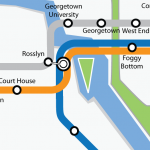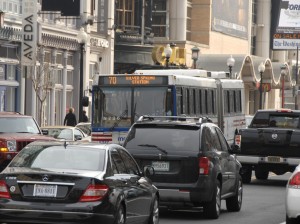
The planned Metrorail Line to Dulles Airport will provide a high-frequency, high-capacity link between the airport and the region’s core, and will enable travel between all Metrorail stations and the airport, without requiring rail-to-bus transfers. Concerns have been expressed about the likely Metrorail travel times between the airport and the core, and the capacity of the Metrorail system, as trains converge through Rosslyn and pass under the Potomac River. Could there be improvements that would provide faster service, expand the capacity, and also provide for greater flexibility for routing trains when service is disrupted, because of either incidents or planned major maintenance?
To attract riders, transit travel times need to “be competitive with” other travel options, yet setting that competitive bar at the level of auto travel times doesn’t seem to be necessary (nor is it readily achievable.) Reagan National Airport attracts many transit trips, even though driving times to the airport are generally shorter than by rail. While travel times need to be competitive, and a faster travel time would be more appealing and attract some more ridership, Metrorail to Dulles Airport will result in considerable transit usage by airport patrons and employees, not only to and from the core, but to Tysons Corner and other locations served by the Metrorail network.
Read more…
 In 1997, the WMATA Board of Directors appointed the Regional Mobility Panel. Made up of members from regional governments as well as business, labor and citizen leaders, the panel was charged with reducing costs and increasing integration of the region’s bus services. In addition to publishing Principles for Coordinated Bus Service in the Washington Metropolitan Area, the panel also identified the need for service planning processes and procedures. The panel recommended service criteria be developed to allow evaluation of regional bus service provided by WMATA. (Regional routes cross jurisdictional lines and are subsidized by all compact jurisdictions.) In consultation with the local jurisdictions the following criteria were developed and integrated into Metrobus Service Adjustment Policies, adopted by the WMATA Board of Directors in February, 2000.
In 1997, the WMATA Board of Directors appointed the Regional Mobility Panel. Made up of members from regional governments as well as business, labor and citizen leaders, the panel was charged with reducing costs and increasing integration of the region’s bus services. In addition to publishing Principles for Coordinated Bus Service in the Washington Metropolitan Area, the panel also identified the need for service planning processes and procedures. The panel recommended service criteria be developed to allow evaluation of regional bus service provided by WMATA. (Regional routes cross jurisdictional lines and are subsidized by all compact jurisdictions.) In consultation with the local jurisdictions the following criteria were developed and integrated into Metrobus Service Adjustment Policies, adopted by the WMATA Board of Directors in February, 2000.
While the criteria were established to evaluate productivity of regional routes, Metro also evaluates non-regional routes the same way. However, routes of a given service type (regional vs. non-regional) are evaluated against average performance criteria of only its own service type. These critical values are calculated annually based on past years’ performance.
- Daily Weekday Passenger Boardings
- Cost Recovery
- Average Subsidy Per Passenger
- Passengers Per Revenue Trip
- Passengers Per Revenue Mile
For a more detailed description of these criteria, please see the Metrobus Service Guidelines document.
Report of the Regional Mobility Panel, 1997 (PDF, 1 MB)

Image from Downtown DC BID
In our discussions about the costs of Metro, it’s worth stepping back and considering the regional benefits our transit system provides – beyond simply another way to get from Point A to Point B. Against a backdrop of funding needs, a crucial question is, “how does the region benefit from continued funding of Metro?”
Since the WMATA Compact was signed in 1967, we have built a 106-mile heavy rail network, the bus and paratransit systems now cover 1,500 square miles, and together we make around 1.2 million trips on the system every day. Our choice to build and use transit has had broad impacts on the region: it has changed the way land is developed, where businesses choose to locate, how the economy grows, how families get around and settle in livable neighborhoods, how we impact the environment, and more. Read more…
 In January 2011 we continued to provide the TAG with model results of several strategies designed to provide more access to transit. The model results of these strategies highlight the myriad methods that can be employed to meet future transit demand in the Washington metropolitan area. During this presentation we also presented the proposed RTSP public engagement strategy; a revised project schedule and solicited jurisdictional representatives for additional strategies they would like to see modeled.
In January 2011 we continued to provide the TAG with model results of several strategies designed to provide more access to transit. The model results of these strategies highlight the myriad methods that can be employed to meet future transit demand in the Washington metropolitan area. During this presentation we also presented the proposed RTSP public engagement strategy; a revised project schedule and solicited jurisdictional representatives for additional strategies they would like to see modeled.
TAG Meeting #6 Presentation (PDF)






Recent Comments